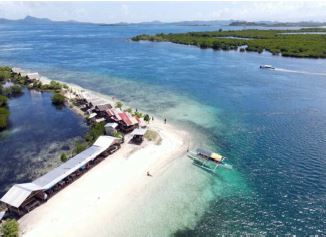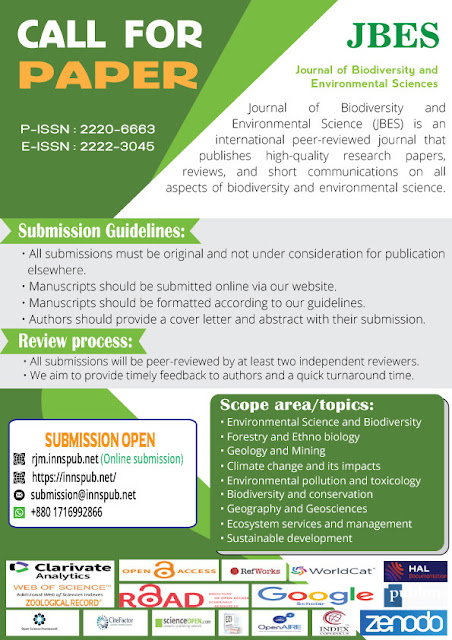Medielyn M. Odtojan,
and Meycel C. Amarille, from the different institute of the Philippines. wrote
a research article about' Day-asan Ecotom Site: Assessing Sustainable
Carrying Capacity uris. entitled, Carrying capacity assessment of the
ecotourism site of day-asan, Surigao City towards sustainable ecotourism. This
research paper published by the Journal of Biodiversity and Environmental Sciences | JBES. an open access scholarly research journal on
Biodiversity, under the affiliation of the International Network
For Natural Sciences | INNSpub. an open access
multidisciplinary research journal publisher.
Abstract
Carrying Capacity is a
tool to prevent and control overutilization of the tourist spots through the
identification of the ideal use level of visitors who can use the site.
Recently, numerous eco-tourism has been developed and the uncontrolled growth
of visitors leading to overcrowding has brought immense concern for sustainable
tourism. The study assessed the carrying capacity of Day-asan ecotourism area
as a basis for management planning. The Limits of Acceptable Change (LAC)
framework was used to assess the carrying capacity. An opportunity sampling was
conducted to 182 visitors and stratified random sampling for the 206 residents
using a structured questionnaire. Key Informant Interview (KII) was carried out
to the members of the Barangay Council, tourism investors/operators, and staff
of the local tourism staff. Results showed that the current condition of the
ecotourism in Day-asan does not pose any threat to its build environment,
ecology, people, and economic status of the area. The maximum number of
visitors received in a day in the area is 345 spent mostly on swimming, and the
calculated carrying capacity estimate is 813 visitors per day which is way
higher than the maximum number of visitors received in the area in a day. The results
of this study can serve as a basis for the Local Government Unit (LGU) and
Surigao Tourism Office in crafting the Tourism Management Plan for the
sustainability of the ecotourism site in Day-asan.
Read more : Green Synthesis of Fe3O4 Nanoparticles from Alternanthera Philoxeroides for Environmental Applications | InformativeBD
Introduction
Ecotourism generates
profits for the host communities and provides revenue for the protection and
conservation of the area. It is usually an excursion to natural areas to learn
the cultural and natural antiquity of the environment without altering the
natural ecosystem while providing opportunities in the economy for the
conservation of natural resources. When it provides a positive change in the
economy, ecotourism can urge conservation and societal building however, it
somehow introduces several changes to the host communities that may impact the
social and economic structure of the area positively or negatively. (Hunter,
1997). Ecotourism became an integral activity in natural areas all over the
world as it gives an opportunity to the visitors to ascertain the significance
of conserving biodiversity and local culture. The International Ecotourism
Society (2020) defined ecotourism as environmentally responsible tourism to
natural areas that encompasses understanding and education to the travelers,
and at the same time, sustain the well-being of local people while conserving
the environment. It is said that ecotourism influences to enhance the natural
environment where can funds be generated for the use of conservation and
protection of the natural resource, to preserve the culture and history, as
well as to set limits for sustainable use (Okech & Bob, 2009).
Carrying Capacity is a
tool to prevent and control overutilization of the tourist spots through the
identification of the ideal use level of visitors who can use the site.
Recently, numerous ecotourism has been developed and the uncontrolled growth of
visitors leading to overcrowding has brought immense concern for sustainable
tourism. In a global context, carrying capacity developed functional management
in terms of economical, ecological, and agricultural aspects. Whereas the local
context of carrying capacity mostly applies such tools for economic and
ecological aspects, specifically, tourism carrying capacity. Since tourism is
booming in the Philippines, carrying capacity is important in planning towards
a sustainable and lasting ecotourism site (H.A. Adorado, personal
communication, September 2020).
The concept of carrying
capacity is engaged in an unusual broad-spectrum of studies and arguments, and
it has been compellingly criticized by different fields (Hobbs et al., 2008).
The study of Butler (1996) argues that utilization of such instruments gives
instruments rise to imperceptibly incremental advancement and alters the
profile of the tourists with regards to those more exposed to higher usage. However,
it is essential for the concept of carrying capacity to be incorporated in the
preparation of tourism and environmental sustainability regardless of
challenges in measurement as introduced by administrations and other
developers. There are many aspects of carrying capacity depending on focus.
However, this study focuses on the four aspects of carrying capacity, the
physical, ecological, social, and economic carrying capacity. The purpose of
this research is to understand the current conditions of eco-tourism of
Day-asan that will serve as an essential instrument for strengthening tourism
and sustainability of the area.
Siargao which is part
of the Province of Surigao del Norte became popular as the surfing capital of
the Philippines. Because of this, the area became one of the favorite tourist
spots in the country. Besides surfing, Surigao offers an array of natural
wonders, there are the Silop multi-caves, Mabua Pebble Beach, Basul Island
hopping, Lake Mainit, Rock Mineral Museum, and many others. But there are still
a lot of people or travelers who don’t know that this off-thebeaten- path
Surigao City has many other attractions to offer. One of them is Day-Asan
Floating Village which is very accessible from the city center. This is one of
the reasons why Day-asan Ecotourism is chosen as a study site.
Though many other
tourist sites are surrounding Surigao City, the Day-as an is the nearest and
has the easiest access. Most tourists prefer to stay in Dayasan where they
could experience all in one what all other tourism spots can offer. The results
of this study can contribute to the crafting of policies of the Barangay Local
Government of Day-asan as well as to the tourism plan of Surigao City for the
sustainability of the existing and the proposed ecotourism sites in the city
and within the province.
Reference
Abernethy VD. 2001.
Carrying capacity: the tradition and policy implications of limits. Ethics in
Science and Environmental Politics 1, 9-18.
Brandolini SMD, Mosetti
AR. 2004. Sustainable tourism development and social carrying capacity: a
case-study on the North-Western Adriatic Sea. WIT Transactions on Ecology and
the Environment 76.
Butler RW. 1996.
The development of tourism in frontier regions: Issues and approaches. Frontiers
in regional development 213-229.
Butler RW. 2019.
Tourism carrying capacity research: a perspective article. Tourism Review.
Calanog L. 2015. A
Manual on Computing Carrying Capacity of Ecotourism Sites in Protected Areas.
Ecosystems Research and Development Bureau, Department of Environment and
Natural Resources, College, Laguna, Philippines. ISBN 978971-8831-48-9.
De Vera M. 2019.
Localized Effective Tourism Carrying Capacity using Tourist Proxemics and
Corrective Factors, The Case of Sabang Beach in Baler, Aurora, Philippines. IOP
Conf. Ser. Earth Environ. Sci. 294 012016.
Declerck M, Verheul M,
Daly D, Sanders R. 2016. Benefits and enjoyment of a swimming intervention
for Youth with Cerebral Palsy: an RCT Study. Pediatric physical
therapy 28(2), 162-169.
Faiz SA, Komalasari RI. 2020.
The assessment of tourism carrying capacity in Lombok Island. In IOP Conference
Series: Earth and Environmental Science (Vol. 592, No. 1, p. 012002).
IOP Publishing.
Hobbs PR, Sayre K,
Gupta R. 2008. The role of conservation agriculture in sustainable
agriculture. Philosophical Transactions of the Royal Society B: Biological
Sciences 363(1491), 543-555.
Hunter C. 1997.
Sustainable tourism as an adaptive paradigm. Annals of tourism research 24(4), 850-867.
International
Ecotourism Society. 2020. Ecotourism-A Path Towards Better Conservation.
https://ecotourism.org/news/ecotourism-a-path-towards-better-conservation/
Okech RN, Bob U. 2009.
Sustainable ecotourism management in Kenya. Ethiopian Journal of Environmental
Studies and Management 2(1).
Pangemanan A, Maryunani
LH, Polii B. 2012. Economic analysis of Bunaken Nasional Park ecotourism
area based on the carrying capacity and visitation level. Asian Transactions on
Basic and Applied Sciences 2(2), 34-40.
Patil DY, Patil LS. 2008.
Environmental Carrying Capacity and Tourism Development in Maharastra.
Quicoy AR, Briones ND. 2010.
Beach carrying capacity assessment of coastal ecotourism in Calatagan,
Batangas, Phlippines. Journal of Environmental Science and
Management 12(2).
Sadikin PN, Arifin HS,
Pramudya B, Mulatsih SRI. 2017. Carrying capacity to preserve biodiversity
on ecotourism in Mount Rinjani National Park, Indonesia. Biodiversitas
Journal of Biological Diversity 18(3), 978-989.
Saveriades A. 2000. Establishing the social tourism carrying capacity for the tourist resorts of the east coast of the Republic of Cyprus. Tourism management 21(2), 147-156.
Source : Carrying capacity assessment of the ecotourism site of day-asan, Surigao City towards sustainable ecotourism











%20in%20full.JPG)


0 comments:
Post a Comment